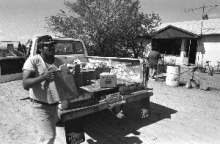Article
Today, there are actually three Ute tribal reservations, the result of European-American settlement and the Colorado Gold Rush that began in 1859. Traditionally, the Ute ranged throughout the Four Corners and the western portion of Colorado, greatly facilitated in mobility as they gained horses from early Spanish settlers and the Plains tribes. However, beginning in 1849 a series of treaties were signed which progressively limited the lands on which the Ute could live. The final reservation boundaries were created as of the 1890s, although litigation in the 20th century restored to the Ute some portions of their traditional lands.
The Northern Ute reservation is on the Utah-Colorado border and was settled by the Whiteriver, Uintah, and Uncompaghre bands. The Southern Ute reservation is in southern Colorado and was settled by the Muache and Capote Utes. The The Ute Mountain Ute reservation is on the Colorado-New Mexico border and was settled by the Weeminuche Ute.
"Delivery from the distribution center on the Ute Mountain Indian Reservation in Towaoc, Colorado, June 1980." Photo courtesy of the National Archives and Records Administration and is licensed under CC BY.
Manuscripts
References
Delaney, Robert W.
1974 The Southern Ute People. Phoenix: Indian Tribal Series.
Delaney, Robert W.
1989 The Ute Mountain Utes. Albuquerque: University of New Mexico Press.
Hart, Gerald T., LeRoy R. Hafen, Anne M. Smith
1974 Confederated Ute Indian Lands. New York: Garland Pub. Inc..
Simmons, Virginia McConnell
2000 The Ute Indians of Utah, Colorado, and New Mexico. Niwot: University Press of
Colorado.
Young, Richard K.
1997 The Ute Indians of Colorado in the Twentieth Century. Norman: University of
Oklahoma Press.

